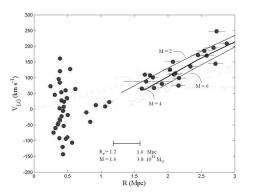Astronomers Detect Cosmic 'Dark Energy' in Galaxies Nearest Earth

(PhysOrg.com) -- An international team of astronomers, including a University of Alabama researcher, have detected effects of "dark energy" within the Local Group of galaxies containing our own Milky Way Galaxy.
Astronomers use the term “dark energy” to describe the mysterious field they believe must be present in the mostly empty space of the Universe in order to cause galaxies’ accelerated movement away from each other.
The team, including Dr. Gene Byrd, professor emeritus of physics and astronomy at The University of Alabama, and researchers from Finland and Russia, presented the research today at the American Astronomical Society meeting in Washington D. C.
The research, published in the most recent issue of the European journal Astronomy and Astrophysics, shows dark energy’s accelerating effects act on “small” scales of millions of light years, in contrast to dark energy’s previous discovery at distances of billions of light years. A light year is a distance of about six trillion miles in length.
The universe is populated with multitudes of galaxies each containing billions of stars and other gravitational matter. The distribution of galaxies is clumpy with most galaxies in systems ranging from groups of a few dozen to rich clusters with thousands.
As a consequence of the Big Bang, these systems are observed, via the lengthening of their spectral wavelengths, known as redshift, to be flying away (receding) from one another, Byrd said. Faster galaxy recessions are seen at greater distances from Earth in the cosmological expansion of the universe.
Besides their cosmological redshifts, individual galaxies in groups show shorter and longer wavelength Doppler shifts because of their internal orbital motions. During the 1980s, team members Byrd, and Mauri Valtonen, of Finland, explained excess internal orbital Doppler member redshifts as resulting from more group members receding from the group centers rather than equal numbers orbiting inward and outward.
The explanation why these members were leaving the groups awaited a new discovery. Until the late 1990s, it was thought that the gravitation of the matter in the universe governed its fate by slowing the expansion, Byrd said.
Astronomers used exploding (supernova) stars to measure much larger distances to galaxies along with their cosmological redshifts. These distances and redshifts indicated an additional mysterious “dark energy” which actually accelerates the recession.
Byrd pointed out that, in contrast to gravity’s decrease in strength with increasing distance, the distant galaxy observations indicate that dark energy acceleration effect increases with increasing distance.
The observations also indicate that, because of the spreading out of gravitating matter as the galaxies recede from one another, since about 6 or 7 billion years ago, dark energy’s “repulsion” actually has dominated gravity.
Using the matter/energy equivalence (E=mc2) from Einstein’s theory of relativity, the relative density proportions today are 72 percent dark energy and only 28 percent gravitating matter.
The next step in understanding, according to Byrd, was soon after the dark energy discovery. Team members Arthur Chernin, of Russia, and Pekka Teerikorpi, of Finland, along with collaborator Yuri Baryshev, realized that dark energy could have effects on motions of galaxies among groups of galaxies at separations much smaller than billions of light years.
The research presented at the meeting takes advantage of the fact that recent Hubble Space Telescope observations give astronomers the individual Local Group members’ distances and Doppler shift velocities with improved accuracy, Byrd said.
At the meeting, Byrd presented plots of distances and Doppler shift velocity observations, showing that near the Local Group center, equal numbers of members approach and recede in orbits forming a bound system.
The Milky Way Galaxy and the Andromeda Galaxy - 2.5 million light years away - dominate this central region comprising most of the gravitating mass. However, the team found that outside a 4.6 million light year transition radius gap, small Local Group members are all receding. At larger distances, the small members recede more rapidly.
The team points out that at the transitional radius gap, the inward gravitation and outward dark energy acceleration add to zero. The increase of recession beyond the transition radius indicates that over a several million light year distance, dark energy’s acceleration increases with distance. This increase is like that previously found from observations of galaxies billions of light years away.
From the results of this paper, Byrd emphasized that ideas on the nature of dark energy should now take into account its accelerating effects and distance dependence at scales 1/1000 those previously seen.
From the Local Group members’ velocities and distances, the transition radius and the age of the universe, the team finds that the “local” dark energy density is consistent with the large distance estimated value. Byrd also said that dark energy effects must be included in estimating the gravitating mass in galaxy groups, with revised estimates of about 4 trillion solar masses for the Local Group.
Provided by University of Alabama

















